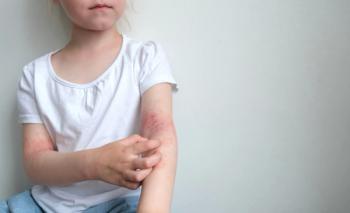
- May 2020
- Volume 90
- Issue 5
Ceramide-Containing Cleansers and Moisturizing Creams Plus Corticosteroids Have a Synergistic Treatment Effect For Atopic Dermatitis (Eczema)
This article is sponsored by CeraVe®.
With the CDC’s guidance for extra handwashing, selecting the appropriate dermatologist recommended cleansers and moisturizers is critical, especially for those with atopic dermatitis.*
*Source: Centers for Disease Control and Prevention. How to Protect Yourself. Updated March, 18 2020. https://www.cdc.gov/coronavirus/2019-ncov/ prepare/prevention.html. Accessed on March 19, 2020.
ATOPIC DERMATITIS
Atopic dermatitis (AD), also known as eczema,1,2 is an inflammatory skin condition characterized by skin dryness (xerosis), itching (pruritis), redness (erythema), excessive skin peeling (desquamation), and areas of lesions or abrasions (excoriations).1-4 Its pathogenic underpinnings are often associated with unknown or unexplainable hypersensitivities.5
Pruritis is the hallmark symptom of AD, and it is usually significant.1,5 It accounts for much of the disease burden, very often resulting in sleep disturbances and other downstream issues.1
Atopic dermatitis affects approximately 10% of the population of the United States.6-12 Approximately 90% of patients develop AD eruptions by age 5, but due to its relapsing course, symptoms can persist into adulthood.1-3 AD is often protracted in nature, manifesting as periods of acute worsening (flares) followed by periods of relative quiescence after treatment.3 Thus, strategies designed to minimize recurring flares are an important part of disease management.3 The pharmacist is uniquely positioned to make recommendations for such strategies as patients present with symptoms of this condition.
SKIN PHYSIOLOGY
The skin is composed of 3 major layers: the hypodermis (the deepest layer), dermis (the middle and thickest layer), and the epidermis (the most superficial layer).13 Within the epidermis are 4 different layers of cells: stratum basale, stratum spinosum, stratum granulosum, and the stratum corneum (SC).13
Keratinocytes are the most abundant cell type within the epidermis13,14; they ultimately become corneocytes as they reach the SC.14,15 The SC is composed of approximately 15 layers of these corneocytes bathed in an extracellular matrix of lipids.13,14
By mass, the lipids that make up the matrix surrounding the corneocytes in the SC are composed of 50% ceramides, 25% cholesterol, and 15% free fatty acids.13,15 This lipid matrix helps the skin retain moisture by reducing transepidermal water loss (TEWL) and functions as a barrier to allergens, harmful microorganisms, and other potential irritants.5,13 Maintaining an optimal composition of lipids in the intercellular corneocyte matrix is crucial for proper barrier function of the SC.13
PATHOPHYSIOLOGY OF AD
Increased TEWL and decreased ceramide levels have been observed in the SC of patients with AD compared with those without AD.16 An increase in TEWL can make the skin dry, cracked, and fissured, making it more prone to allergen invasion and a subsequent immune response causing inflammation.5,13 An increase in TEWL itself may trigger a surge in pro-inflammatory cytokine production.17 Genetic factors have also been implicated in AD pathogenesis.5 Regardless of the exact mechanism, AD involves a complex interplay between a dysfunctional skin barrier and a dysregulation of immune responses.1,18
CERAMIDES
Ceramides are a class of lipids composed of a long-chain fatty acid linked to a sphingoid moiety via an amide bond.13 Their name derives from the amide linkage and their de novo synthesis pathway in the epidermis using L-serine and palmitoyl-CoA.13
Eleven different families of ceramides have been identified in human skin based upon their fatty acid and sphingoid moiety.16 Ceramides are a major component of the intercellular lipid matrix of the SC and, as such, are critical to proper barrier function and controlling TEWL.14,17 In 1 ex vivo study, ceramide synthesis in the epidermis over a 24-hour period was reduced in skin from patients with AD compared with healthy volunteers.18
GUIDELINE-BASED TREATMENT OPTIONS FOR AD: TOPICAL CORTICOSTEROIDS AND MOISTURIZERS
Evidence-based treatment guidelines for AD from the American Academy of Dermatology (AAD) recommend the use of moisturizers and topical corticosteroids (TCSs) as the cornerstone of treatment.2,3 Moisturizers are recommended as the main primary treatment for mild AD and as part of the regimen for moderate and severe AD because they have been shown to lessen pruritis, dryness, erythema, fissuring, and lichenification and aid in the prevention of AD flares.2,5 Although few head-to-head trials exist between different commercially available moisturizers,2 investigators have noted the following: (1) Lotions with a high water content can be drying because of an evaporative effect,5 (2) thicker emollients with a high lipid content are preferred,5 (3) moisturizers with mixtures of ingredients that match physiologic proportions of lipids (ceramides, cholesterol, and free fatty acids) can penetrate through a disrupted SC and incorporate into the SC interstices,13,14 and (4) the application of moisturizers containing nonphysiologic rational mixtures of lipids may do more harm than good.13
TCSs are used to address the inflammation associated with AD. Although typically reserved for periods of flare, they can also be used to prevent relapses, as long as the frequency of application is reduced to once or twice weekly.2 Because prolonged use of TCSs has been associated with side effects such as skin atrophy, striae, telangiectasias (spider veins), purpura and easy bruising, skin fragility, increased infection risk, and acne rosacea, it is important that TCSs are used judiciously.2,5,17,19
CLINICAL EVIDENCE FOR TOPICAL CERAMIDES
In a 4-week randomized study of 60 participants with mild to moderate eczema [AD], the addition of a ceramide-containing liquid cleanser and a ceramide-containing moisturizing cream to a high-potency corticosteroid exerted a synergistic treatment effect.4 Those who received the TCS (fluocinonide cream 0.05%) twice daily plus the ceramide-containing cleanser and cream twice daily had significant improvement in symptoms at 1 week, comparable to the improvement seen at 4 weeks with the fluocinonide without the ceramide-containing products (disease severity score as assessed by a dermatologist was 1.6 at week 1 with ceramide-containing products vs 1.6 at week 4 with a mild cleanser bar alone).4 Compared with those using a mild bar cleanser, significantly more patients using the ceramidecontaining cleanser and moisturizing cream were clear of symptoms by week 4 (
FIGURE
).4
In a Canadian cohort study of patients with mild to moderate AD, all participants were assessed at baseline for AD symptomology and again after 6 weeks of using a ceramidecontaining cleanser and ceramide-containing cream twice daily.20 At the end of the study period, improvements were observed in skin dryness, crusting/oozing, pruritis, and overall AD symptoms.20
CERAVE® PRODUCTS
CeraVe® skin care products contain a blend of 3 synthetic but bioidentical ceramides (ceramides 1, 3, and 6-II),4 along with fatty acids and other lipids to help restore the skin’s natural barrier. Moisturizing ingredients are delivered to the skin’s surface through a time-released multivesicular emulsion technology, which releases ingredients over the course of 24 hours, layer by layer. Concentric layers of oil-in-water emulsions called vesicles unfold and release when placed on the skin.4 These products can be an excellent moisturizing treatment option for those with AD.13
ROLE OF THE PHARMACIST
The AAD clinical practice guidelines state that education is an extremely important facet of AD treatment because of the complex pathogenesis of AD and the likelihood of requiring multiple, sometimes rotating, therapies.3 Pharmacists are uniquely positioned to provide such teaching as they interface with patients with AD and others who may be seeking relief for minor symptoms with OTC products. CeraVe® products can be recommended with confidence because of the proven efficacy of their formulas and unique delivery system as demonstrated in clinical trials.
References
1. Eichenfield LF, Tom WL, Chamlin SL, et al. Guidelines of care for the management of atopic dermatitis: Section 1: Diagnosis and assessment of atopic dermatitis. J Am Acad Dermatol. 2014;70(2):338-351.
2. Eichenfield LF, Tom WL, Berger TJ, et al. Guidelines of care for the management of atopic dermatitis: Section 2: Management and treatment of atopic dermatitis with topical therapies. J Am Acad Dermatol. 2014;71(1):116-132.
3. Sidbury R, Tom WL, Bergman JN, et al. Guidelines of care for the management of atopic dermatitis: Section 4: Prevention of disease flares and use of adjunctive therapies and approaches. J Am Acad Dermatol. 2014;71(6):1218-1233.
4. Draelos ZD. The effect of ceramide-containing skin care products on eczema resolution duration. Cutis. 2008;81:87-91.
5. Simpson EL, Leung DM, Eichenfield LF, Boguniewicz M. Chapter 22: Atopic Dermatitis. In: Kang S, Amagai M, Bruckner AL, Enk AH, Margolis DJ, McMichael AJ, Orringer JS. eds. Fitzpatrick's Dermatology, 9e. 2019: New York, NY: McGraw-Hill.
6. Barbarot S, Auziere S, Gadkari A, et al. Epidemiology of atopic dermatitis in adults: Results from an international survey. Allergy. 2018;73(6):1284—1293. doi:10.1111/all.13401.
7. Abuabara K, Magyari A, McCulloch CE, Linos E, Margolis DJ, Langan SM. Prevalence of atopic eczema among patients seen in primary care: data from the Health Improvement Network. Ann Intern Med. 2019;170(5):354—356. doi:10.7326/M18-2246.
8. Hanifin JM, Reed ML; Eczema Prevalence and Impact Working Group. A population-based survey of eczema prevalence in the United States. Dermatitis. 2007;18(2):82—91. doi:10.2310/6620.2007.06034.
9. Chiesa Fuxench ZC, Block JK, Boguniewicz M, et al. Atopic dermatitis in America study: a cross-sectional study examining the prevalence and disease burden of atopic dermatitis in the US adult population. J Invest Dermatol. 2019;139(3):583—590. doi:10.1016/j.jid.2018.08.028.
10. Shaw TE, Currie GP, Koudelka CW, Simpson EL. Eczema prevalence in the United States: data from the 2003 National Survey of Children's Health. J Invest Dermatol. 2011;131(1):67—73. doi:10.1038/jid.2010.251.
11. Silverberg JI, Hanifin JM. Adult eczema prevalence and associations with asthma and other health and demographic factors: a US population-based study. J Allergy Clin Immunol. 2013;132(5):1132—1138. doi:10.1016/j.jaci.2013.08.031.
12. Silverberg JI. Public health burden and epidemiology of atopic dermatitis. Dermatol Clin. 2017;35(3):283—289. doi:10.1016/j.det.2017.02.002.
13. Sahle FF, Gebre-Mariam T, Dobner B, Wohlrab J, Neubert RHH. Skin diseases associated with the depletion of stratum corneum lipids and stratum corneum lipid substitution therapy. Skin Pharmacol Physiol. 2015;28:42-55.
14. Proksch E, Jensen JM, Elias PM. Skin lipids and epidermal differentiation in atopic dermatitis. Clin Dermatol. 2003;21:134-144.
15. Kendall AC, Kiezel-Tsugunova M, Brownbridge LC, Harwood JL, Nicolaou A. Lipid functions in skin: Differential effects of n-3 polyunsaturated fatty acids on cutaneous ceramides, in a human skin organ culture model. Biochim Biophys Acta Biomembr. 2017;1859(9 Pt B):1679-1689. doi: 10.1016/j.bbamem.2017.03.016.
16. Ishikawa J, Narita H, Kondo N, et al. Changes in the ceramide profile of atopic dermatitis patients [letter]. J Invest Dermatol. 2010;130:2511-2514.
17. Del Rosso JQ, Cash K. Topical corticosteroid application and the structural and functional integrity of the epidermal barrier. J Clin Aesthet Dermatol. 2013;6(11):20—27.
18. Macheleidt O, Kaiser HW, Sandhoff K. Deficiency of epidermal protein-bound omega-hydroxyceramides in atopic dermatitis. J Invest Dermatol. 2002;119:166-173.
19. Kao JS, Fluhr JW, Man MQ et al. Short-term glucocorticoid treatment compromises both permeability barrier homeostasis and stratum corneum integrity: inhibition of epidermal lipid synthesis accounts for functional abnormalities. J Invest Dermatol. 2003;120(3):456-464.
20. Lynde CW, Andriessen A. A cohort study on a ceramide-containing cleanser and moisturizer used for atopic dermatitis. Cutis. 2014;93:207-213.
Articles in this issue
over 5 years ago
Interactives: Case Studies (May 2020)over 5 years ago
Pet Peeves (May 2020)over 5 years ago
Palforzia From Aimmune Therapeutics Incover 5 years ago
Spread the Word About Medication Therapy Management Servicesover 5 years ago
Acne Can Be Troublesome But Responds to Treatmentover 5 years ago
Drug Manufacturers Must Increase Transparency During Pandemicover 5 years ago
Generic Products (May 2020)Newsletter
Stay informed on drug updates, treatment guidelines, and pharmacy practice trends—subscribe to Pharmacy Times for weekly clinical insights.




















































































































































































































